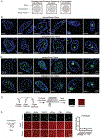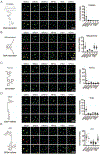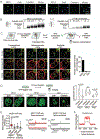Partitioning of cancer therapeutics in nuclear condensates
- PMID: 32554597
- PMCID: PMC7735713
- DOI: 10.1126/science.aaz4427
Partitioning of cancer therapeutics in nuclear condensates
Abstract
The nucleus contains diverse phase-separated condensates that compartmentalize and concentrate biomolecules with distinct physicochemical properties. Here, we investigated whether condensates concentrate small-molecule cancer therapeutics such that their pharmacodynamic properties are altered. We found that antineoplastic drugs become concentrated in specific protein condensates in vitro and that this occurs through physicochemical properties independent of the drug target. This behavior was also observed in tumor cells, where drug partitioning influenced drug activity. Altering the properties of the condensate was found to affect the concentration and activity of drugs. These results suggest that selective partitioning and concentration of small molecules within condensates contributes to drug pharmacodynamics and that further understanding of this phenomenon may facilitate advances in disease therapy.
Copyright © 2020 The Authors, some rights reserved; exclusive licensee American Association for the Advancement of Science. No claim to original U.S. Government Works.
Figures




Comment in
-
Drug modulation by nuclear condensates.Science. 2020 Jun 19;368(6497):1314-1315. doi: 10.1126/science.abc5318. Science. 2020. PMID: 32554584 Free PMC article. No abstract available.
-
Drugs enter a liquid phase.Nat Rev Mol Cell Biol. 2020 Aug;21(8):419. doi: 10.1038/s41580-020-0268-2. Nat Rev Mol Cell Biol. 2020. PMID: 32601401 No abstract available.
-
Partitioning of Chemotherapeutics into Nuclear Condensates-Opening the Door to New Approaches for Drug Development.Mol Cell. 2020 Aug 20;79(4):544-545. doi: 10.1016/j.molcel.2020.07.029. Mol Cell. 2020. PMID: 32822580
-
Understanding the phase separation characteristics of nucleocapsid protein provides a new therapeutic opportunity against SARS-CoV-2.Protein Cell. 2021 Sep;12(9):734-740. doi: 10.1007/s13238-021-00832-z. Epub 2021 Mar 26. Protein Cell. 2021. PMID: 33770364 Free PMC article. No abstract available.
References
-
- Shin Y, Brangwynne CP, Liquid phase condensation in cell physiology and disease. Science (80-.) 357, eaaf4382 (2017). - PubMed
-
- Hyman AA, Weber CA, Jülicher F, Liquid-Liquid Phase Separation in Biology. Annu. Rev. Cell Dev. Biol 30, 39–58 (2014). - PubMed
-
- Langdon EM, Gladfelter AS, A New Lens for RNA Localization: Liquid-Liquid Phase Separation. Annu. Rev. Microbiol 72, 255–271 (2018). - PubMed
Publication types
MeSH terms
Substances
Grants and funding
LinkOut - more resources
Full Text Sources
Other Literature Sources
Medical

